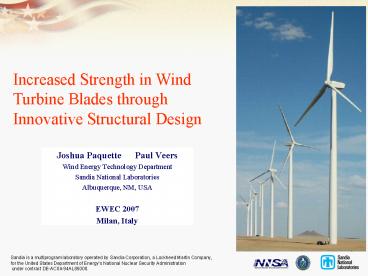Joshua Paquette Paul Veers - PowerPoint PPT Presentation
1 / 29
Title:
Joshua Paquette Paul Veers
Description:
... airfoils created by the symmetric addition of thickness about the camber line ... which 'chop' the trailing edge off and thus lose camber. Advantages ... – PowerPoint PPT presentation
Number of Views:39
Avg rating:3.0/5.0
Title: Joshua Paquette Paul Veers
1
Increased Strength in Wind Turbine Blades through
Innovative Structural Design
- Joshua Paquette Paul Veers
- Wind Energy Technology Department
- Sandia National Laboratories
- Albuquerque, NM, USA
- EWEC 2007
- Milan, Italy
2
Overview
- Blade Research at Sandia National Laboratories
- CX-100 and BSDS 9 m Blade Designs
- Carbon in Blades
- Flatback Airfoils
- Blade Testing
- Acoustic Emissions Monitoring
- Finite Element Modeling
3
Blade Research at Sandia National Laboratories
4
Blade Research at Sandia National Labs
- SNL initiated a blade research program in 2002 to
investigate the use of carbon in blades along
with other advanced structural concepts - Objective stronger, lighter blades
- Three 9 m blade designs were produced
- CX-100 (Carbon Experimental 100 kW)
- TX-100 (Twist-Bend Coupled Experimental 100 kW)
- BSDS (Blade System Design Study)
- Laboratory and field tests conducted to evaluate
the designs and to validate modeling tools
5
CX-100
- Manufactured using existing 9 m molds
- Based on ERS-100 blade with NW-100 root
- Glass-Epoxy blade with full length carbon spar
cap - Conventional design methodology
Aerodynamic
Structural
Manufacturing
CX-100 Blade Skin
6
TX-100
- Identical geometry to CX-100
- Partial length glass spar cap
- 20 off-axis carbon in outboard (gt3.5 m) skins
to produce material-induced, passive aerodynamic
load alleviation
Source NREL
Material Induced Twist-Bend Coupling
Glass Spar Cap
Off-axis Carbon Skin
TX-100 Blade Skin
7
BSDS
- Advanced design
- Flatback airfoils
- Full-length constant thickness
- Carbon spar cap
- Embedded root studs
- High performance airfoils
- Large, thin root
- 8.325 m in length
- Arrived at through system design approach
Flatback
Large Root with Embedded Studs
Aerodynamic
BSDS Blade
Structural
Manufacturing
8
CX-100 and BSDS 9 m Blade Designs
9
CX-100 and BSDS Blade Designs
CX-100
Carbon Spar Caps
BSDS
CX-100
BSDS
Span (m)
Flatback Airfoils
High Performance Airfoils
Root
Max-Chord
CX-100
BSDS
Tip
10
Carbon in Blades
- Advantages
- High stiffness/weight ratio
- Excellent properties with straight fibers
- Disadvantages
- Higher cost
- Limited availability
- Difficult to infuse
- Poor properties with wavy fibers
- Potential solution SAERTEX glass/carbon triax
fabric - Relatively inexpensive
- Permeable
- Dry fabric for conventional infusion techniques
- Maintains excellent fiber straightness
Common Dry Carbon Fabrics
SAERTEX Glass/Carbon Triax used in SNL 9 m Blades
Study of carbon materials performed in
collaboration with GEC and MSU
11
Flatback Airfoils
Creation of Flatback Airfoils
- Flatback airfoils created by the symmetric
addition of thickness about the camber line - Different from truncated airfoils which chop
the trailing edge off and thus lose camber - Advantages
- Structural
- Increased sectional area
- Increased sectional moment of inertia
- Aerodynamic
- Increased maximum lift coefficient
- Reduced sensitivity to surface soiling
- Disadvantages
- Increased drag
- Unknown and complex 3D flow
- Greater aero-acoustic emissions
- One solution for increasing thickness, others
exist such as thick airfoil families
Flatback Flow Field
Possible Trailing Edge Treatments to Reduce Drag
Source Tanner (1973)
Study of flatback airfoils performed in
collaboration with UC Davis
12
Blade Testing
13
Testing Setup
CX-100 and BSDS Test Loads
Blade Extreme Root Moments CX-100 86.4
kN-m BSDS 53.8 kN-m
Whiffle-Tree Loading Arrangement
Test Loading Distribution
Test Loading Sequence
14
Testing Setup
Static Blade Tests for CX-100 (left) and BSDS
(right) at the NWTC
15
Testing Results
Blade Deflections (left) and Spar Cap Strains
(right) under Test Loading
16
Testing Results
BSDS Flatback Strains under Test Loading
17
Testing Results
Comparison of CX-100 and BSDS Blade Properties
and Testing Results
Historical Comparison of 9 m Blade Weights and
Strengths
18
Acoustic Emissions Monitoring
19
Acoustic Emissions Monitoring Background
Initiation of Acoustic Waves from Source
Arrival Times of Acoustic Wave for Two Separated
Sensors
Typical Acoustic Wave Signature
Acoustic Wave Hitting Sensor Field
Source ASTM (2003)
20
Acoustic Emissions Monitoring
Locations and Intensities of Detected CX-100
Acoustic Events
21
Acoustic Emissions Monitoring
Locations and Intensities of Detected CX-100
Acoustic Events
Post-test Photo of CX-100 Shear Web Bond Line at
1200-1300 mm
22
Acoustic Emissions Monitoring
Locations and Intensities of Detected BSDS
Acoustic Events
23
Acoustic Emissions Monitoring
Locations and Intensities of Detected BSDS
Acoustic Events
Post-test Photo of BSDS Shear Web Termination at
350 mm
24
Acoustic Emissions Monitoring
Acoustic Energy Accumulation for CX-100 (left)
and BSDS (right) Tests
25
Finite Element Modeling
26
Finite Element Modeling
- CX-100 and BSDS finite element models created
with NuMAD ANSYS pre and postprocessor developed
at Sandia National Laboratories - Models created using offset and mid-node shell
elements - Loads applied to simulate test loading
CX-100 and BSDS Finite Element Models
27
Finite Element Modeling Results
CX-100
BSDS
Strain Field
Linear Buckling
28
Finite Element Modeling Results
FEA and Measured Blade Deflections under Test
Loading
FEA and Measured Blade Spar Cap Strains under
Test Loading
29
Conclusions
- Lighter, stronger blades can be improved through
a system design approach where aerodynamic,
structural, and manufacturing constraints are met
in unison - Acoustic emissions monitoring is a valuable tool
for determining when and where a blade is
incurring damage in laboratory environment - FEA tools can be used to accurately predict
strains, displacements, and buckling































